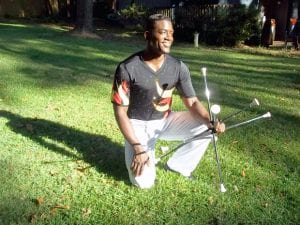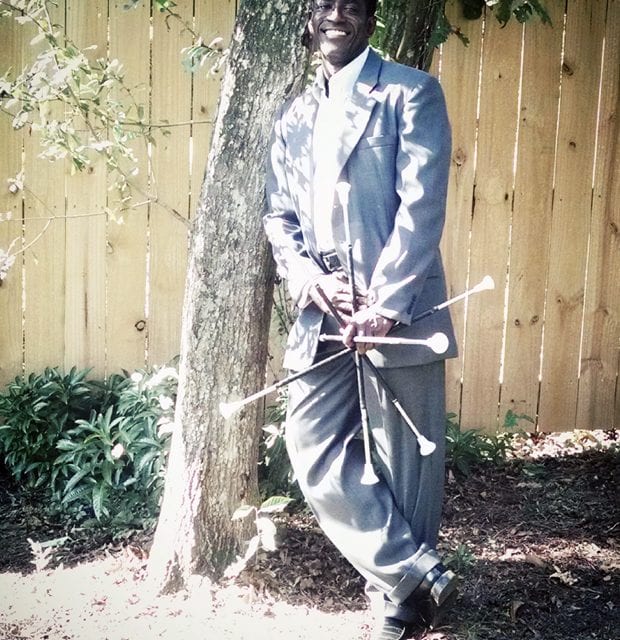It took decades, but baton master Bobe McBride has pursued his dream

JONANNA WIDNER | Contributing Writer
About 30 years ago, when Bobe McBride was in middle school, he played trombone in the marching band, positioned right behind the majorettes, their batons flashing and glinting in the sun as the majorettes twirled and tossed them. Even though he was there to play music, McBride was immediately transfixed by what he saw in front of him; he decided he’d much rather be doing that than playing an instrument.
But, he says with a laugh, “I was a black man in the rural South. That was not gonna happen.”
Not then, maybe. But now, at age 44, McBride is happily and confidently pursuing a passion. As one of the most decorated masters of baton twirling in the United States, Bobe McBride is a United State Twirling Association (USTA) national and Florida state champion, National Baton Twirling Association Florida state champion and Twirltacular grand champion.
Competitive baton twirling — or “twirl sport” as practitioners call it — has evolved long past the stereotypical Friday Night Lights majorette in white boots and a sparkly vest that most people envision. Twirl sport is a complex, difficult athletic endeavor.
“It’s more akin to rhythmic gymnastics,” McBride says. “It’s a combination of floor exercise, tumbling, keeping an apparatus moving, and developing a style.”
Twirl sport competition is judged similarly to gymnastics or diving, with competitors awarded points for execution of moves and skills, with more points awarded based on the difficulty of the skill. It can be incredibly challenging, requiring a combination of aerobic endurance, strength and coordination — something that casual observers may not fully appreciate. McBride cites a movement called an “illusion” as an example.
“It’s a one-legged cartwheel where your hands never touch the ground. One leg makes a complete circle,” he explains. “When done well it looks so cool.”
Advanced twirl athletes often add as many as four batons to their routines at one time, adding to the technical difficulty. If they drop a baton while doing a trick, judges subtract points from their final score. Routines can last from 30 seconds to several minutes.
Twirl competitors often translate their talent to entertainment displays as well … which is what McBride will be doing when he joins up with the award-winning Black Gold Color Guard at this year’s Alan Ross Texas Freedom Parade during Dallas Pride.
Also marching with the color guard will be the Oak Lawn Band, which will be playing “Safety Dance,” “We Are Family,” “Firework” and more along the parade route. “All the while, our twirlers will be doing routines and our color guard will be spinning sabres, rifles and flags,” say Tony Daniel, public relations director for the Oak Lawn Band.
 McBride finally got his chance to dive into twirl sport when he was 24. Driving down the road with a friend, he saw a car with a baton shoe-polished onto the window. Another car passed with similar decoration. Then another. It was clear the convoy was headed to a competition.
McBride finally got his chance to dive into twirl sport when he was 24. Driving down the road with a friend, he saw a car with a baton shoe-polished onto the window. Another car passed with similar decoration. Then another. It was clear the convoy was headed to a competition.
“I said, ‘I want to go wherever they’re going,’” McBride says. His friend grudgingly obliged and followed the cars until they found themselves in the midst of a huge twirl sport competition.
His friend got bored and left, but McBride was hooked. “I was enthralled,” he says. “I stayed all day.” He made several contacts at the competition, found someone to give him lessons, and 20 years later, he’s got three United States Twirling Association championships under his belt.
The first time he won, McBride says, was the moment when everything came together.
“I did a program to Jackie Wilsons ‘Your Love.’ I had one drop but it was the one time I felt completely relaxed,” he says. “Athletes talk about being in the zone and I’ve never known was that meant until that moment.”
McBride, the color guard and the Oak Lawn Band will all perform Sunday marching in the Alan Ross Texas Freedom Parade.
















